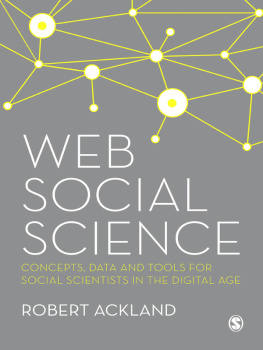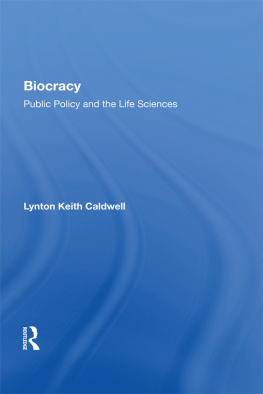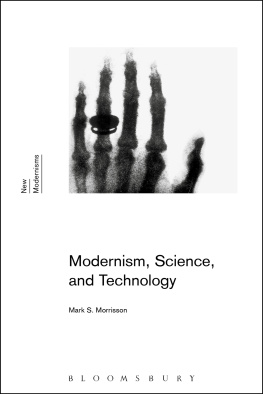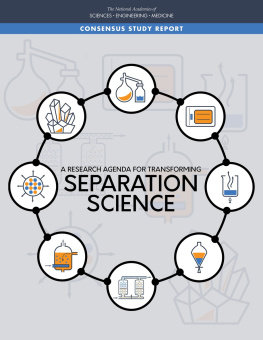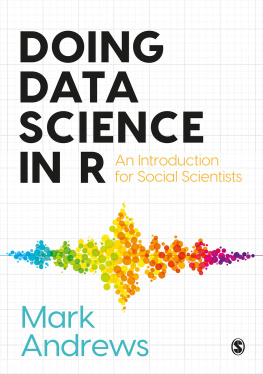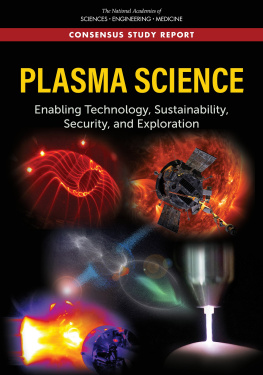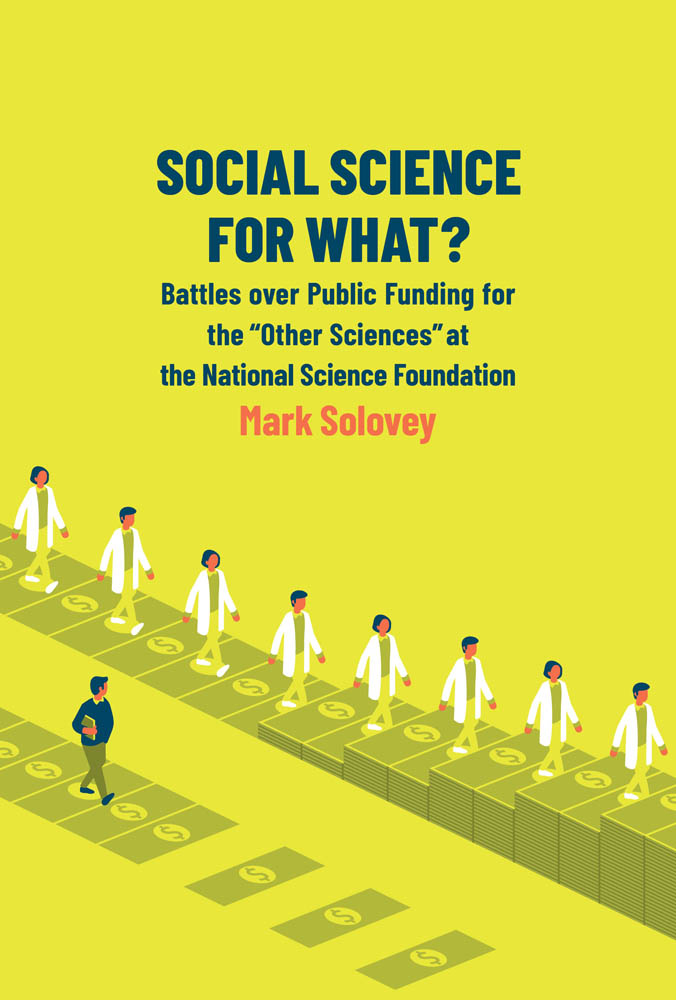BATTLES OVER PUBLIC FUNDING FOR THE OTHER SCIENCES AT THE NATIONAL SCIENCE FOUNDATION
The open access edition of this work was made possible by generous funding from the MIT Libraries. This work is subject to a Creative Commons CC-BY-NC-ND license.
Subject to such license, all rights are reserved.
Names: Solovey, Mark, 1964- author.
Title: Social science for what? : Battles over public funding for the other sciences at the National Science Foundation / Mark Solovey.
Description: Cambridge, Massachusetts : MIT Press, [2020] | Includes bibliographical references and index.
Subjects: LCSH: National Science Foundation (U.S.) | Social sciences--Research--United States--History. | Research--United States--Finance--History. | Endowment of research--United States--History.
CONTENTS
LIST OF FIGURES
President Truman, Vannevar Bush, and National Defense Research Committee members, January 20, 1947. Seated left to right: James Conant, Harvard University president; President Harry S. Truman; and Alfred N. Richards, National Academy of Sciences president. Standing left to right: Karl T. Compton, MIT president; Lewis H. Weed, National Research Council Division of Medical Sciences chairman; Vannevar Bush, Office of Science and Development director; Frank B. Jewett, National Academy of Sciences former president; J. C. Hunsaker, National Advisory Committee for Aeronautics chairman; Roger Adams, University of Illinois chemist; A. Baird Hastings, Harvard Medical School; and A. R. Dochez, Columbia University. Copyright Unknown, Courtesy of Harry S. Truman Library and Museum.
Edwin Nourse Reports to President Trumans Cabinet, October 3, 1947.
Front row, left to right: Acting Secretary of State Robert Lovett, Secretary of Defense James Forrestal, President Harry S. Truman, Secretary of the Treasury John Snyder, and Attorney General Tom C. Clark. Standing, left to right: Vice Chairman of the Economic Advisory Council Leon Keyserling, Postmaster General Robert Hannegan, Assistant to the President John Steelman, Secretary of Commerce Averell Harriman, Secretary of Agriculture Clinton Anderson, Chairman of the Economic Advisory Council Edwin Nourse, Secretary of the Interior Julius Krug, Secretary of Labor Lewis Schwellenbach, and Federal Works Administrator Philip Fleming. Copyright Unknown. Courtesy of Harry S. Truman Library and Museum.
Harry Alpert, instructor and PhD candidate at Columbia University, meeting with a student, ca. 1937. Courtesy of the Alpert family.
National Science Foundation organizational chart as of 1955. Nondivisional administrative offices have been omitted.
Father Hesburgh at Illinois Rally for Civil Rights, Chicagos Soldier Field, June 21, 1964. Left to right: Rev. Edgar Chandler, Rev. Theodore M. Hesburgh, Rev. Martin Luther King, Jr., and Msgr. Robert J. Hagarty of Chicago. Copyright Unknown. Courtesy of Notre Dame Archives.
Social Science Struggles for Recognition and Funding at the NSF. Published with the article The Knowledge We Need Most by Harry Alpert in Saturday Review, February 1, 1958, pp. 3638.
Henry W. Riecken during his early NSF days, ca. 1958. Courtesy of the Riecken family.
National Science Foundation organizational chart as of June 1961. Nondivisional administrative offices have been omitted.
NSF Social Science Research Obligations as Percentage of NSF Total Research Obligations, 19561969. Data compiled from Tables 3.2 and 4.1 of Otto N. Larsen, Milestones and Millstones: Social Science at the National Science Foundation, 19451991 (New Brunswick, NJ: Transaction Publishers, 1992).
Jerome Bruner and a young grade school student working with MACOS materials, ca. 1969. Courtesy of Educational Development Center, Inc.
Emilio Daddario (Center), U.S. Democratic Representative from Connecticut and Chairman of the House Subcommittee of Science, Research and Development, with U.S. Astronauts Neil Armstrong, Edwin Aldrin, and Michael Collins, September 16, 1969. Courtesy of Wesleyan University Library, Special Collections & Archives.
Fred R. Harris, U.S. Democratic senator from Oklahoma, with members of the Kerner Commission, created in 1967 by President Johnson to study the problems of racial unrest and develop solutions. Harris is seated in the center and looking at the camera. Courtesy of Fred R. Harris.
Senator William Proxmire talks with President Carter in the White House, January 18, 1978. Photo by White House Photographer, courtesy of Wisconsin Historical Society, WHS-30077.
Sherry Ortner in Nepal for her dissertation research, ca. 1967. Courtesy of Sherry Ortner.
Richard Atkinson speaking with President Carter in the White House, March 15, 1977. Photo by White House photographer. Courtesy of the NSF.
National Science Foundation organizational chart as of June 1975. Nondivisional administrative offices have been omitted; only the divisions under Directorate for Research are shown.
National Science Foundation organizational chart as of July 1975. Nondivisional administrative offices have been omitted; only divisions under the disciplinary Directorates are shown.
Federal obligations for basic research, social and behavioral sciences vs. life sciences, National Science Foundation, 19761988 (dollars in millions). Data from table 2L, federal obligations for basic research, by detailed fields of science and engineering: National Science Foundation, fiscal years 19702003. In National Science Foundation, Division of Science Resources Statistics, Federal Funds for Research and Development: Fiscal Years 19702003, NSF 04-335, Project Officer Ronald L. Meeks (Arlington, VA, 2004). Amounts for Life Sciences computed by adding separate amounts for Biological Aspects of Psychology in table 2L; amounts for Social and Behavioral Sciences computed by adding separate amounts for Social Aspects of Psychology in table 2L.
Herbert Simon giving a lecture, ca. 1972. Courtesy of Carnegie Mellon University.
David Stockman, looking like the Grim Reaper, scrutinizes a social scientist who is hopelessly tangled up in his studies, while a chopping block nearby awaits its next victim. The cartoon caption reads, Do you have a study there showing that nine out of ten social scientists are dispensable? Cartoon appeared in the Washington Star, June 30, 1981.
Kenneth Prewitt, former U.S. Census Bureau director (19982001) and former SSRC president (19791985), receives the SAGE-CASBS Award, in recognition of his important contributions to the understanding and advancement of the social and behavioral sciences as applied to important social issues, November 6, 2015. Left to right: Margaret Levi, Center for Advanced Study in the Behavioral Sciences executive director; Kenneth Prewitt; and Sara Miller McCune, cofounder of SAGE Publishing. Courtesy of Center for Advanced Study in the Behavioral Sciences.


